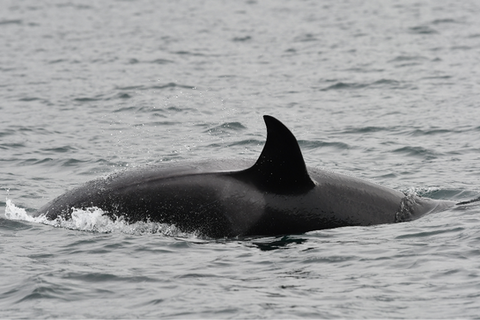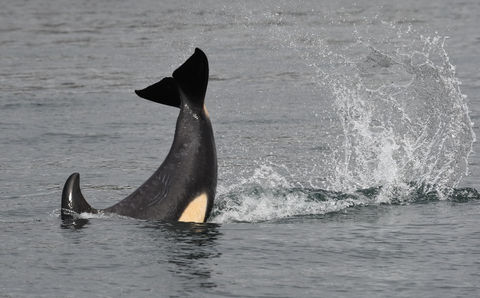
A BREACH and a BLOW during 2023 OS Encounter #44 with J, K, and L pod members (Photograph by Mark Malleson).
Orca
As whale watchers, you will observe orcas (killer whales) demonstrating many different Instantaneous and Prolonged maneuvers or behaviors. The physical actions described or shown below (or both) include the behavior name, what happens, and in some instances, explain why.

All photographs and information on whalesearch.com are Copyright © 2024 Center for Whale Research.
Instantaneous Orca BEHAVIORS
When possible, the above Orca BEHAVIORS photographs are linked to the ORCA SURVEY Encounter. Learn the physical features of an orca at About ORCAS / APPEARANCE & MORPHOLOGY.
Instantaneous Orca BEHAVIORS
AERIAL SCAN—Raises its head at an angle starting from a horizontal position; it may do this to take a look above the surface.
BACK DIVE—Leaps out of the water, exposes two-thirds or more of its body, and lands on its back.
BELLY FLOP—Leaps out of the water, exposes two-thirds or more of its body, and lands on its ventral surface (i.e., stomach).
BLOW—Surfacing blowhole exhale before taking in a gulp of fresh air.
BREACH—Leaps out of the water, exposing two-thirds or more of its body, then lands on its side.
BURP—An above-surface vocalization that sounds like it’s “letting gas.”
BUBBLE BLOWING—Blowing bubbles while underwater; sometimes, the air released through its blowhole produces a sound.
CARTWHEEL—Throws its flukes, caudal peduncle, and rear part of its body from one side to another in at least a 45-degree arc (sometimes called a Peduncle Throw).
DORSAL FIN SLAP—Rolls on its side and hits the broad side of its dorsal fin on the surface with force.
FLUKE LIFT—Moves its flukes up and down above the water surface in a fluid motion with no force; often seen in conjunction with kelping.
FLUKE WAVE—Lifts its flukes and part of its caudal peduncle above the water, pauses for at least two seconds, and then brings its flukes down with no force; often observed when kelping.
HALF BREACH—Leaps out of the water and exposes only half of its body, landing on its side.
INVERTED PECTORAL SLAP—While on its back, raises its pectoral flippers straight up and slaps the dorsal surfaces down on the water's surface (often an inverted pectoral slap is immediately followed by an inverted tail lob).
INVERTED TAIL LOB—On its back, it raises its flukes above the water’s surface, bringing them down with force.
KELPING—“Plays” with kelp or seaweed by dragging it on any body part; often, it tries to position the kelp in the notch of its flukes.
LUNGE—Breaks the ocean surface with its rostrum, melon, and a large part of its body in a charging mode (the lunge often has a sideways component, especially when the whale is chasing something).
MATING—A male inserts his penis into a female's genital slit.
PECTORAL SLAP—Lies on its side, lifts a pectoral flipper, and slaps it on the water's surface with force.
PECTORAL WAVE—Lifts a pectoral flipper in the air for at least two seconds and brings it down with no force.
ROLLING—Rolls halfway or all the way around in the water along its longitudinal axis (this behavior is beneficial for researchers in determining the sex of an orca).
SEA SNAKE—The pink penis of an adult male, which can attain a length of three feet.
SPYHOP—Raises its head vertically above the water, at least above its eye level, perhaps to look around, and then slips back below the ocean surface.
TACTILE—Physical contact with another orca (e.g., caressing one another with their pectoral flippers or rubbing rostrums).
TAIL LOB/TAIL SLAP—Lifts its tail flukes above the water, bringing them down with force.
TAIL THRASHING—Violently thrashes a tail fluke through the water surface (often observed when in pursuit of prey).
All photographs and information on whalesearch.com are Copyright © 2024 Center for Whale Research.
Prolonged Orca BEHAVIORS
When possible, the above Orca BEHAVIORS photographs are linked to the ORCA SURVEY Encounter. Learn the physical features of an orca at About ORCAS / APPEARANCE & MORPHOLOGY.
CHASING—Making sudden movements, including lunges and sudden accelerations (e.g., when in pursuit of prey).
CIRCLING—Making circling movements, often in the context of a chase.
DIRECTION CHANGE—Changing its direction of travel and proceeding in a new direction, often preceded by milling.
FEEDING—Seen with its prey.
GROUPS SPREAD OUT—Tight groups of whales separated by 100 yards/meters or more.
JOINED—Individuals or groups who have just “joined” with one or more other individuals or groups.
LOGGING—Resting at the water surface, exposing its melon, upper back, and part of its dorsal fin for at least 10 seconds.
LOOSE—Individuals traveling 30-50 yards/meters apart.
MILLING—Surfacing in constantly varying directions while remaining in the same area.
PORPOISING—Traveling at high speed with the majority of their bodies breaking the surface and often creating a "V" of spray alongside their bodies (at top speed, an orca can rise up to seven feet above the water’s surface and leap 30-35 feet horizontally).
SPLIT—Individuals or groups who move away from another individual or a group.
SPREAD OUT—Predominately traveling as individuals and separated by distances of 100 yards/meters or more.
SUPERPOD—When EVERY member of J, K, and L pods are present and together.
TIGHT—Almost in physical contact with one another when traveling in a group.
TRAVEL FAST—Traveling at a speed of more than five knots.
TRAVEL MEDIUM—Traveling at a speed of three to five knots.
TRAVEL SLOW—Traveling at a speed of one to two knots.





























